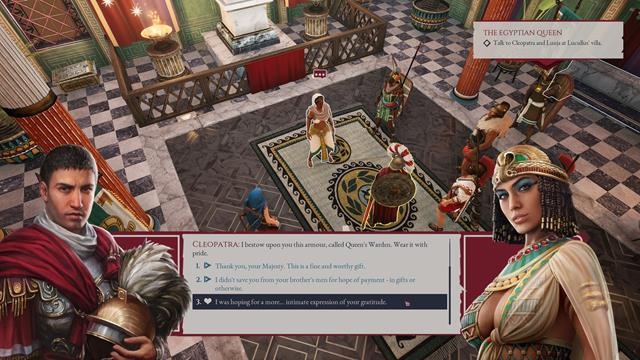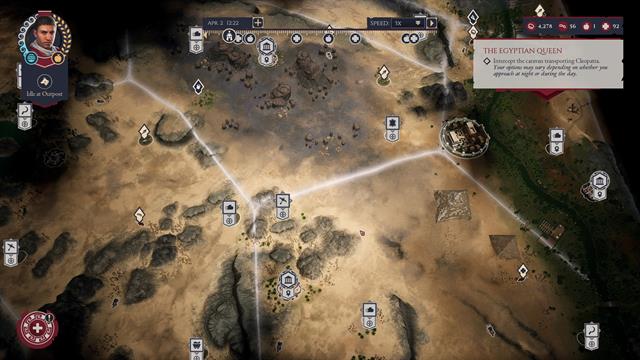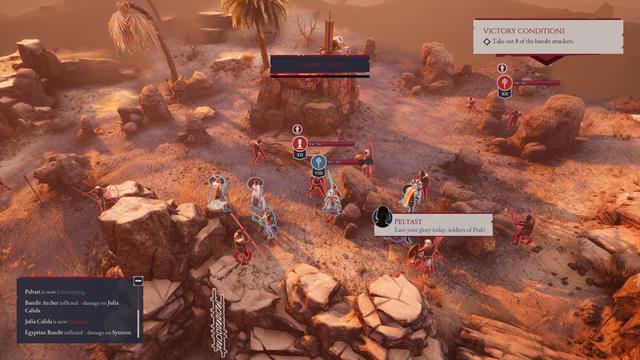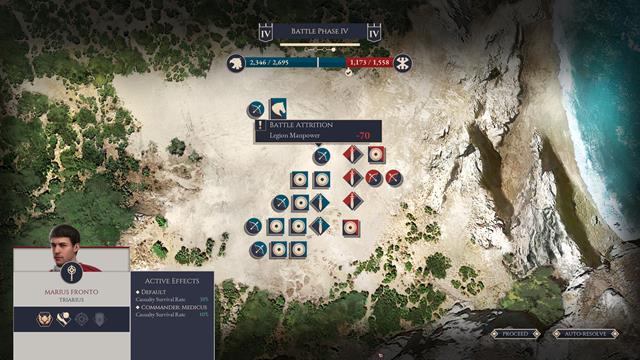Expeditions: Rome is a massive game. From the grassy plains of Asia Minor to the sandy dunes of North Africa, I traveled with Legio VI Victrix. I defeated armies to capture settlements, and I emerged unscathed from skirmishes against hostile squads.
Still, with just over 25 hours of playtime under my belt, I’ve realized that I’ve progressed no further than the halfway point of the Expeditions‘ second act so far. Normally, you’d think that you hadn’t scratched the surface of such an enormous endeavor within that time. Unfortunately, it feels as though I’ve experienced all that the game has to offer.
Expeditions: Rome Review-in-Progress — Marching Ever Onward
Expeditions: Rome puts you in the role of a Roman commander from a Patrician family. Your father has been slain and your in-laws have sinister designs. At the start, you’ll choose a class and meet none other than Julius Caesar himself. Then, as you progress a bit further in the campaign, there’s a twist where you realize that you’re about to carve out your own destiny.
Along the way, you’re aided by unique companions. There’s your loyal friend, Caeso Quinctius Aquilinus, as well as Syneros, a trusted advisor. Soon, you’ll meet Bestia, a fighter who’s got a chip on his shoulder, as well as Julia Calida, masquerading as a man so she could join the army. Much later, your group is rounded out by Deianeira, a gladiator whom you’ll free from servitude.
The revolving door of personages doesn’t stop there, as you’re also introduced to historical characters, some of whom are integral to the plot. We’ll leave those for you to experience yourself.

Past games in the Expeditions franchise have emphasized exploring the world map with your merry band. In Expeditions: Rome, however, you’ll get to lead the Legio VI Victrix.
You’ll still roam around to visit villages and points of interest akin to an RPG, though your legion will bear the brunt of Conquest Battles, clashes between your army and a hostile force that controls a region, such as Asia Minor, North Africa, or Gaul. These Conquest Battles are presented as an overhead tactical map where small icons move automatically. In each phase, three cards known as Strategems are drawn. Pick one, and you’ll see an outcome.
When your legion conquers a sector, you’ll be able to undertake missions to pacify it, as well as send your forces to occupy infrastructure. You’ll then receive resources that can be used to upgrade the buildings in your outpost.

This is just the meta-game in Expeditions: Rome. The core component as you advance the narrative is your regular party. You’re not just limited to your companions, as you’re allowed to recruit generic soldiers who can become Praetorians (party members) in their own right.
All characters belong to a particular class. For instance, Caeso and Deianeira are Princeps, the “tanking class.” Bestia, meanwhile, is a Veles, the assassin archetype that can easily flank foes and deliver quick strikes with dual-wielded weaponry.
As for Julia, she’s a Sagittarius, but it doesn’t mean that she likes Leos and hates Capricorns. Rather, the Sagittarius is your archer class, with an “overwatch-esque” ability to boot. Lastly, there’s the Triarius class, which is what Syneros is. It provides utility and healing effects for your team.

Combat with your party in Expeditions: Rome follows a tactical turn-based affair similar to its predecessors and others in the genre. Characters move to hexes and use their abilities to drop their foes. Planning and effective target selection are also vital, so you can chain kills, sunder armor, eliminate incapacitated opponents, or gain buffs through flanking maneuvers.
Moreover, because you’re allowed to recruit generic characters, you can build a squad to suit your playstyle. Do you want several Triarii for endless healing, free action refreshes, and AoE boosts? That’s perfectly fine. Alternatively, you could bring multiple Sagitarii if you want to hang back and snipe anything that comes your way.
Similarly, you’ll partake in siege battles, which are the culmination of each act. These are multi-phase tactical encounters where your entire party is required (you’ll split them into squads to tackle different objectives in a fortress). During the final engagement, everyone regroups to push back the last remaining enemies. You even get to use catapults to rain death from afar.

On paper, Expeditions: Rome has a lot going for it. Regrettably, there are a few things that get in the way.
Despite everything, the Conquest meta-game becomes tiresome the further you get into the campaign. When I first started taking over the territories in Asia Minor with my legion, it was like a breath of fresh air. I truly felt that there was a grand adventure that awaited me. Then, a few hours later, I started begging Expeditions: Rome to stop making this mechanic a requirement to advancement.
Indeed, the main quest requires you to pacify five regions at first, then seven, then 10, and then all 13 to advance to the next act. Later, there is a similar requirement in Act 2. “Here we go again,” I muttered to myself, cursing the predicament.
It doesn’t help matters that Conquest Battles are uninteresting and the Strategem cards you received to complete them are drawn randomly. In the same vein, your outpost buildings basically act as menus, with subsequent upgrades only improving their boosts.

This feeling of disappointment is further compounded by random events on the world map. To be fair, this is a staple that I tend to like in various games. However, because there are dozens of regions that must be conquered, and owing to the fact that you need to let in-game time pass between certain actions, you’re going to experience numerous random events.
Many of these have outcomes that must be avoided to keep characters from getting injured, dodge dialogue options that cause approval/loyalty drops, or keep your army from losing rations. As such, it comes to a point where reloading saves to prevent RNG-based mishaps is a common occurrence.
The tactical side of things in Expeditions: Rome is less problematic, but a few oversights still crop up. For instance, characters assigned to outpost facilities can’t be inspected, which means you have to remember their perks and unlocked skills.

On top of that, you won’t be able to respec skill points. You have to live with your decisions if you build your companions a certain way and the abilities turn out to be lackluster eventually.
In the case of generic Praetorians, your pool of recruits has random, premade builds already, and I had two options if I wanted the right abilities. The first was to “save scum” until I found a character that I liked. The second was to dismiss my army leaders and rehire them as regular party members. This was to ensure that I had high-level soldiers with skill points that could still be allocated.
Expeditions Rome Review-in-Progress — The Bottom Line So Far

Pros
- Turn-based mechanics offer significant tactical depth.
- Classes have distinct capabilities and battlefield roles.
- Party composition allows freedom to mix-and-match different or identical classes.
- Dual, interchanging loadout system allows for versatility.
- A decent narrative with key twists.
- Appearances by real-life historical figures.
- Companions with their own personalities and traits.
- Unique items that can truly impact skills trees and builds.
- Dismantling system that allows you to craft unique variants.
- Secrets and sidequests.
- Siege battles and catapults.
Cons
- Lengthy Conquest meta-game devolves into a tedious slog.
- Bland army battles with RNG-based card draws.
- Passing time on the world map leads to random events (which is fine). But too much would mean save-scumming to avoid disastrous outcomes.
- RNG-based Legion recruitment.
- Rhetorical Style dialogue options are rarely used.
Expeditions: Rome is ambitious in size and scope. Those who’ve played the previous games in the franchise would be surprised by the sheer scale of its campaign. Sadly, there are a few missteps on the strategic side of things that veer into tedium, even if the tactical battles keep you on your toes.
So far, I feel as though I’ve seen everything that Expeditions: Rome has to offer on the mechanics side of things, even though I’m only in Act 2. I’m genuinely engaged with the story, quests, and tactical battles. Likewise, I love the challenge presented by lengthy siege battles. Unfortunately, what I still can’t stomach is the meta-game slog just to progress.
[Note: THQ Nordic provided the Expeditions: Rome key used for this review-in-progress.]







Published: Jan 18, 2022 04:00 am